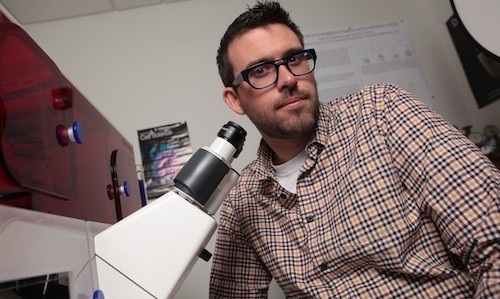New faculty member G.W. Gant Luxton is making headway against dystonia, a common movement disorder.
G.W. Gant Luxton has memories of his Uncle Vince’s mother, Gerry, trembling from Parkinson’s Disease. Sadly, his uncle also developed the disease in his early 40s. Luxton witnessed its devastating effects on their lives and the lives of their family members.
Gerry died from Parkinson’s Disease when Luxton was 24, around the time he needed to decide on a focus for his research. He selected dystonia, a similar neurological movement disorder that would allow him to explore his intense interest in the cytoskeleton and cell polarity.
It was a good match for his personal and research interests at the time. And it provided just the right launching point for his career. The University recently nominated Luxton for the Mallinckrodt Foun
“Gant’s nomination reflects the great science he did as a graduate student and a postdoc, and his potential for uncovering a new disease mechanism that will hopefully lead to a treatment for this disease,” said Michael O’Connor, head of the Department of Genetics, Cell Biology and Development, where Gant is a new assistant professor.
Scientists have identified mutated genes in different forms of dystonia, but it’s not clear how these mutations result in the disease. Luxton hopes to identify the basic cellular functions performed by the protein products of these dystonia-associated genes with the goal of discovering a “dystonia pathway” that might be disrupted in patients. He focuses on the most common and severe inherited form of dystonia, called DYT1 or early onset torsion dystonia, which begins to manifest in children when they are 11-12 years old.
Luxton believes that dystonia may result from the inability of cells to polarize. Neurons, the cell type affected by dystonia, are highly polarized cells characterized by a nucleus-containing cell body and axon that projects from the cell body. Defects in cell polarity may disrupt the function of neurons and consequently disrupt movement.
"What I really enjoy about working on dystonia is that it allows me to do practical, applied cell biology," Luxton says. "In trying to determine how mutations in dystonia-associated genes disrupt the molecular machinery that controls cell polarity and function we hope to better our understanding of this fascinating aspect of basic cell biology as well as identify potential therapeutic targets.”
In the short-term, Luxton plans to screen a variety of small molecules in order to find candidates that have the potential to restore cell polarity in cells from DYT1 dystonia patients. Ultimately, he hopes to discover medications and gene therapies that will help restore coordinated movement in patients.
A graduate of Grinnell College and Northwestern University, Luxton completed postdoctoral research at Columbia University before joining the University of Minnesota in September 2011. His outstanding educational track record gave him multiple faculty position choices. He picked the University because of the strength of the Department of Genetics, Cell Biology and Development.
“The department was the biggest draw,” he says. “I’ve got really great colleagues. I feel very supported and I’m really happy to be here.”